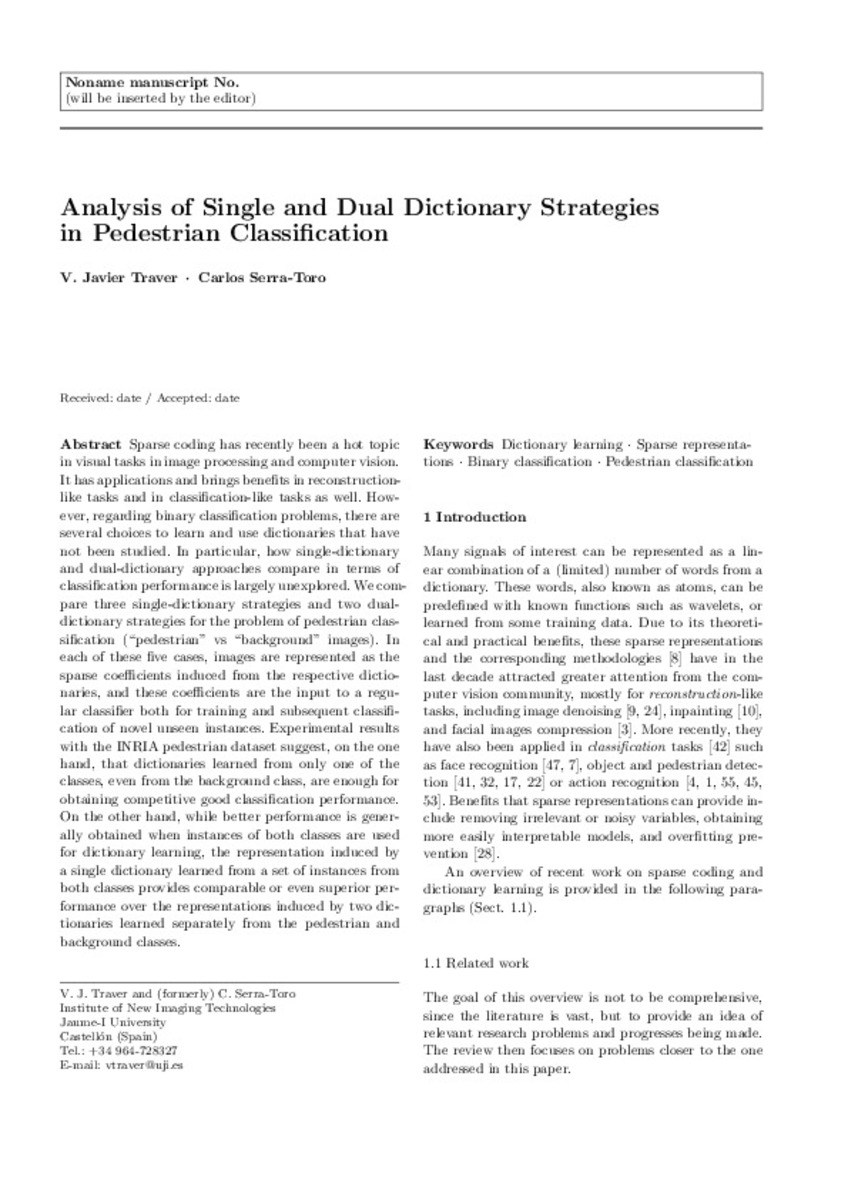Mostra el registre parcial de l'element
Analysis of single‑ and dual‑dictionary strategies in pedestrian classification
| dc.contributor.author | Traver Roig, Vicente Javier | |
| dc.contributor.author | Serra Toro, Carlos | |
| dc.date.accessioned | 2018-06-11T09:29:00Z | |
| dc.date.available | 2018-06-11T09:29:00Z | |
| dc.date.issued | 2018 | |
| dc.identifier.citation | Traver, V.J. & Serra-Toro, C. Pattern Anal Applic (2018). https://doi.org/10.1007/s10044-018-0704-5 | ca_CA |
| dc.identifier.issn | 1433-7541 | |
| dc.identifier.issn | 1433-755X | |
| dc.identifier.uri | http://hdl.handle.net/10234/175078 | |
| dc.description.abstract | Sparse coding has recently been a hot topic in visual tasks in image processing and computer vision. It has applications and brings benefts in reconstruction-like tasks and in classifcation-like tasks as well. However, regarding binary classifcation problems, there are several choices to learn and use dictionaries that have not been studied. In particular, how single-dictionary and dual-dictionary approaches compare in terms of classifcation performance is largely unexplored. We compare three single-dictionary strategies and two dual-dictionary strategies for the problem of pedestrian classifcation (“pedestrian” vs “background” images). In each of these fve cases, images are represented as the sparse coefcients induced from the respective dictionaries, and these coefcients are the input to a regular classifer both for training and subsequent classifcation of novel unseen instances. Experimental results with the INRIA pedestrian dataset suggest, on the one hand, that dictionaries learned from only one of the classes, even from the background class, are enough for obtaining competitive good classifcation performance. On the other hand, while better performance is generally obtained when instances of both classes are used for dictionary learning, the representation induced by a single dictionary learned from a set of instances from both classes provides comparable or even superior performance over the representations induced by two dictionaries learned separately from the pedestrian and background classes. | ca_CA |
| dc.format.extent | 16 p. | ca_CA |
| dc.format.mimetype | application/pdf | ca_CA |
| dc.language.iso | eng | ca_CA |
| dc.publisher | Springer Verlag | ca_CA |
| dc.relation.isPartOf | Pattern Anal Applic (2018) | ca_CA |
| dc.rights | © Springer-Verlag London Ltd., part of Springer Nature 2018. “This is a post-peer-review, pre-copyedit version of an article published in Pattern Analysis and Applications. The final authenticated version is available online at: https://doi.org/10.1007/s10044-018-0704-5". | ca_CA |
| dc.rights.uri | http://rightsstatements.org/vocab/InC/1.0/ | * |
| dc.subject | Dictionary learning | ca_CA |
| dc.subject | Sparse representations | ca_CA |
| dc.subject | Binary classification | ca_CA |
| dc.subject | Pedestrian classification | ca_CA |
| dc.title | Analysis of single‑ and dual‑dictionary strategies in pedestrian classification | ca_CA |
| dc.type | info:eu-repo/semantics/article | ca_CA |
| dc.identifier.doi | https://doi.org/10.1007/s10044-018-0704-5 | |
| dc.relation.projectID | TIN2013-46522-P ; PROMETEOII/2014/062 | ca_CA |
| dc.rights.accessRights | info:eu-repo/semantics/openAccess | ca_CA |
| dc.relation.publisherVersion | https://link.springer.com/article/10.1007/s10044-018-0704-5 | ca_CA |
| dc.date.embargoEndDate | 2019-04-07 | |
| dc.type.version | info:eu-repo/semantics/acceptedVersion | ca_CA |
Fitxers en aquest element
Aquest element apareix en la col·lecció o col·leccions següent(s)
-
INIT_Articles [747]







